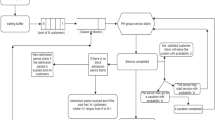Abstract
A generalization of theD [X]/D/1 queue is investigated, where independent and identically distributed (i.i.d) batches of customers arrive at a single-server queue periodically. The service requirement of a customer is a fixed constant equal for all the customers. In the time between two successive arrivals, the server can accommodate exactlyK≥1 customers. The queue size and the waiting time distributions for the infinite buffer queue are derived. Important numerical aspects are addressed and simple approximations for light and heavy traffic for various values ofK and Poisson distributed batches are proposed. Finally, the analysis for the finite queue is highlighted and its blocking probability derived.
Similar content being viewed by others
References
C. Bisdikian, J.S. Lew and A.N. Tantawi, The generalizedD [X]/D/1 queue and its application in the analysis of bridged high speed token-ring networks, IBM Research Report RC18387 (Oct. 1992).
C. Bisdikian, Performance analysis of single-stage output buffer packet switches with independent batch arrivals, Comput. Networks ISDN Syst. 27(1995)627–652.
S.C. Borst, O.J. Boxma and M.B. Combé, Collection of customers: A correlatedM/G/1 queue,Proc. ACM SIGMETRICS and Performance '92 (1992) pp. 47–59.
P.E. Boudreau, J.S. Griffin, Jr. and M. Kac, An elementary queueing problem, Amer. Math. Monthly 69(1962)713–724.
O.J. Boxma, H. Levy and U. Yechiali, Cyclic reservation schemes for efficient operation of multiple queue single-server systems, Ann. Oper. Res. 35(1992)187–208.
M.A. Evgrafov,Analaytic Functions (Dover Publ., New York, 1966).
J.F. Hayes,Modeling and Analysis of Computer Communications Networks (Plenum Press, New York 1984).
J.S. Lew, On the Darling-Mandelbrot probability density and the zeros of some incomplete gamma functions, IBM Research Report RC17242 (1991).
J.A. McFadden, On the lengths of intervals in a stationary point process, J. Roy. Statist. Soc. B24(1962)364–383.
R.O. Onvural,Asynchronous Transfer Mode Networks: Performance Issues (Artech House, Boston, 1994).
A.G. Pakes, Some conditions for ergodicity and recurrence of Markov chains, Oper. Res. 17(1969)1058–1061.
R.A. Silverman,Introductory Complex Analysis (Dover Publ., New York, 1972).
E.M. Spiegel, C. Bisdikian and A.N. Tantawi, Characterization of the traffic on high-speed tokenring networks, Perf. Eval. 19(1994)47–72.
Author information
Authors and Affiliations
Rights and permissions
About this article
Cite this article
Bisdikian, C., Lew, J.S. & Tantawi, A.N. The generalizedD [X]/D/1 queue: A flexible computer communications model. Telecommunication Systems 6, 127–146 (1996). https://doi.org/10.1007/BF02114290
Received:
Revised:
Issue Date:
DOI: https://doi.org/10.1007/BF02114290




